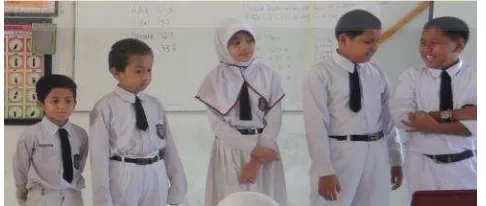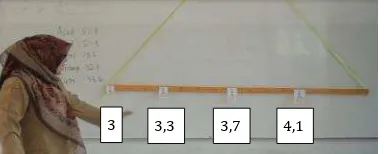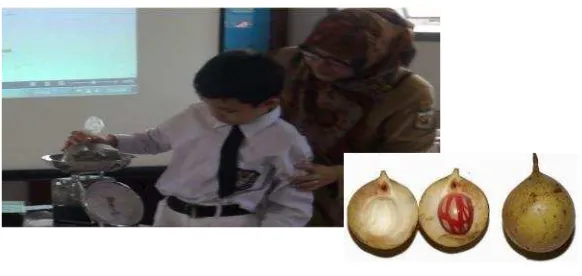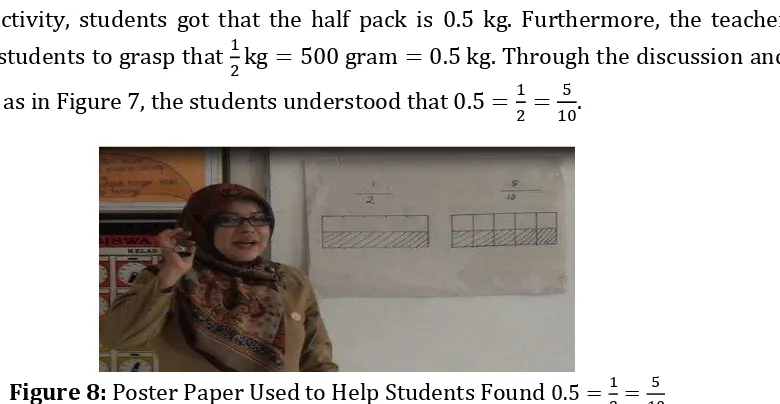MEDIA FOR ORDERING DECIMAL NUMBERS ON THE THEMATIC
LEARNING AT FOURTH GRADE OF ELEMENTARY SCHOOL
Cut Morina Zubainur1, Rahmah Johar2, Cut Khairunnisak3 Syiah Kuala University1,2,3
1) [email protected], 2) [email protected], 3) [email protected]
Abstract
Topic of decimal numbers is taught in fourth grade based on curriculum 2013. Therefore, teachers should strive to help students understand decimals and ordering decimals. One effort that can be done is using media in accordance with the material being taught and the learning theme. It is therefore necessary to design a learning trajectory that includes an ordering decimal numbers accompanied by the media. The aim of this paper was to discuss the implementation process of media of the learning trajectory for ordering decimal numbers; the learning trajectory itself was designed based on realistic approach in thematic learning at fourth grade of elementary school. This research was a case study involving one teacher and 30 fourth grade students of elementary school in Banda Aceh, Indonesia. Data were collected through observation and video recording. During the teaching experiment, the researchers and some observers recorded and took notes about what happen in the classroom, especially about the use of the media. This study provided information about the media that can be used in learning to order decimal numbers associated with thematic learning. The results showed that there were advantages and disadvantages of media used. In addition, it was still difficult for teacher to help students to order decimal numbers. As the implication, this study provided information about media and learning trajectory that can be applied by teachers on the subject of ordering decimal numbers.
Keywords: media, learning trajectory, ordering decimal numbers, realistic approach, thematic learning
INTRODUCTION
Curriculum 2013 sets that elementary school students have to experience integrated thematic learning. Integrated thematic is a teaching and learning approach whereby many competencies from different subjects are connected within a theme. The highlight of this approach is student’s activities during the lesson, thus the students can build up their own knowledge and understanding. Integrated thematic approach has a purpose to let students learn the lesson in a holistic way, as reflected on the various themes given (Kementrian Pendidikan dan Kebudayaan, 2014).
line with Cemalettin (2011) who said that students tend to have difficulty in comprehending decimal numbers. Students often memorized or remembered the order of decimals as written on their book or as the strategies taught by their teacher (Markovits & Even, 1999). As the result, students learn without understanding.
Alsawaie (2012) said that many students thought that 2.54 is more than 2.7 because number 54 is more than 7. This condition showed that there was a need for teachers to use a particular effort to help students in finding that there are many decimal numbers between two certain decimals. One of teacher’s efforts to help students understanding the order of decimals is the utilization of learning media. By using learning media, it is easier for the teacher to design a meaningful learning experiences for students.
Teacher needs to bridge the learning goal and the level of students’ proficiencies (Cemalettin, 2011), such as by using learning media. The media used should be relevant to the learning theme, thus it can help students to fully understand the topic. As the learning tools, learning media also play a role to help students that are in concrete level to understand the abstract mathematical concepts (Kelly, 2006).
Curriculum 2013 emphasized on the utilization of various learning media. The
government provided student’s book and teacher’s book including the learning steps and
its media. However, it was still a minimum suggestion so that the teacher are recommended to develop it based on students’ need.
Considering issues above, the aim of this paper was to discuss the implementation process of media of the learning trajectory for ordering decimal numbers; the learning trajectory itself was designed based on realistic approach in thematic learning at fourth grade of elementary school. Thus, the research question for this study formulated as How is the result of teaching experiment using media in the learning trajectory of ordering decimal numbers?
THEORETICAL FRAMEWORK Learning Media
Learning is a process of changing. Students themselves do the changes to their knowledge, whereas teacher acted as facilitator, mediator, and mentor. Teacher helps students to change their knowledge by preparing a scaffolding and a guidance so that the students can achieve a more perfect understanding. Teachers prepared an effective ladder and the students climb the ladder to get a better understanding (Dole & Sinatra, 1998; Santyasa, 2007).
to manage the information and the environment as learning facility (Ibrahim, Sihkabuden, Suprijanta, & Kustiawan, 2001). The learning environment itself consists of learning places, methods, media, evaluations, and tools and infrastructures needed to help students learn easily. A professional teacher is required to be able to choose and to use an appropriate leaning media (Santyasa, 2007).
The media is functioned as a messenger from communicator to communicant (Criticos, 1996). Learning media is any means can be used as messenger (learning material), so that it can stimulate students’ attention, interest, mind, and students’ feeling in learning to achieve the learning goals (Santyasa, 2007).
Learning media can encourage students to involve in learning process so that they get the optimal result (Sudjana & Rivai, 1991). The use of media in learning process could draw students’ interest and motivation. This statement is in line with what have been said by Arsyad (2010), learning media could clear up the message presentation and information so that it could enhance learning process and learning result. The learning media could also enhance and direct students’ attention, hence, students’ motivation to learn through direct interaction. The restrictiveness of students, concerned to their senses, space and time could be overcome with the learning media. Besides, learning media can give students a similar experiences about events happened at their environment, and make it possible to them to interact directly with the teacher and the other learning sources.
Sudjana and Rivai (1991) explained that learning media consist of as follows. (i) Graphic media as pictures, photos, graphs, diagrams, posters, cartoons, and
comics. Having length and width, the graphic media is often called two dimensional media.
(ii) Three dimensional media is a media in the form of solid model, stacked model, work model, diorama, and so on.
(iii) Projection model as slide, OHP, et cetera.
Realistic Approach
Realistic approach is a specific approach on mathematics education emphasizing on students own construction of understanding through contextual problem (Hadi, 2005). The realistic approach is expected to reform the quality of mathematics education in Indonesia by training teachers to perform a meaningful mathematics lesson for students (van Velzen, 2010). The effort was expected to enhance mathematical understanding and develop students’ logical reasoning (adi, 005 .
learning trajectory. Realistic approach considers the learning trajectory as an important aspect (Sembiring, Hadi, & Dolk, 2008).
In designing the activities to learn the order of decimal numbers, a teacher should dig ideas to make conjectures or hypothesis and should consider student’s reactions for each phase of the learning trajectory. The learning trajectory of ordering decimal numbers includes conjectures about the students and the instructions or guidelines to support the learning process. The supports of the learning process consist of learning goals, activities to achieve the learning goals, supported media, and proactive rules about teacher’s role.
The using of media in the learning trajectory implemented in this study followed the principle of realistic approach as stated by Marja van den Heuvel-Panhuizen (1996), that are activities, realities, hierarchy, intertwine, interactions, and guided reinvention. The learning trajectory was planned so that students’ could obtain their own concept of ordering decimal numbers through the designed activities. The activities was designed by considering the students’ thinking level so that the concept of ordering decimal numbers become real for students. Besides, because of the topic of ordering decimal numbers is included in the theme My (ero , the topic was intertwined with the other topics which was also included in the theme. Furthermore, the learning trajectory was designed by taking into account the interactions between student and teacher as well as those between student and their friends through guided reinvention.
METHOD
This study was a part of a larger research about developing video of teaching decimals through realistic approach. The larger research had three steps: pilot experiment, teaching experiment 1, and teaching experiment 2. This study only focused on the media of the second lesson about ordering decimal numbers from teaching experiment 2. This research was a case study involving one grade four teacher of an elementary school in Banda Aceh, Indonesia. The teacher in this study was selected because of some considerations: (i) she teaches at elementary school, (ii) she is a partner teacher of PMRI, and (iii) she has an adequate academic background. Besides, this study include 30 fourth grade students as participants.
The model teacher acted as the teacher on the teaching experiment. She also participated in designing the learning trajectory, by giving suggestion to the learning trajectory, writing lesson plan, student’s activity sheets, and media to be used. The learning trajectory was designed based on realistic approach.
RESULT AND DISCUSSION
The subject matter for the second lesson of the teaching experiment 2 was ordering decimal numbers. The model teacher started the lesson by apperception that there are decimals between two positive integers. Fragment 1 is an excerpt of the apperception.
Fragment 1: Apperception of the Lesson 1 Teacher : Give me the example of decimal numbers! 2 Student : , ma’am.
3 Teacher : Very good. Give me a decimal between 3 and 4! 4 Student : ,5 ma’am.
5 Teacher : Where is the 3,5?
6 Student : 3,5 is in the middle of 3 and 4.
7 Teacher : Yes, very good. You still remember what we have learned.
As the media, the teacher used picture of number line that she prepared previously (Figure 1a). This help the teacher to present an accurate number line without using much time to draw it.
(a) (b)
Figure 1: Number line prepared by the teacher
The exact scale of the number line figure help students to determine easily what decimal number should be placed on the number line. The students emerged their sense that the decimal that should be placed in the middle of 3 and 4 is 3,5. As can be seen from Figure 1b, students also can exactly determine the place of number 5,4; that is a little bit less than the middle point of 5 and 6.
Next, the teacher gave motivation for the students, that decimal is important in the daily life, by discussing about the distance between some place as showed in the following figure (Figure 2).
The Figure 2 displayed by the help of LCD projector, thus all students could easily see it. The figure help students to find the example of decimals in daily life so that they realized that learning about decimals is important.
After presenting the learning goals, the teacher showed the picture of a temple in Indonesia, named Candi Penataran. The teacher also displayed information of the temple, the information itself consisted of decimal numbers. The purpose of showing Candi Penataran was to make a link between the activity of ordering decimals and the learning theme.
Figure 3: Picture of Candi Penataran and the Information
Next, the teacher asked a student to order the decimal number written in the information of the Candi Penataran. In order to make it more meaningful for the students, the teacher instructed some students to measure their weight. Five students (with different weight) was chosen to measure their weight. The other students were asked to guess the order of those five students based on their body size. Then, they were asked to relate it with the result of weighing. As the result, the students had experiences to order decimal numbers based on their friends’ weight. )n this activity, the teacher used body scale.
Figure 4: Students Stood Based on Their Body Size and the Result of Weighing Activity
Before weighing their body with the body scale, the students already predicted how the order is. This helped students to determine the order of weighing result. Figure 4 showed the order of the five students based on the prediction and the weighing activity.
The next activity was playing cards of decimal numbers. The teacher motivated the students to order decimal numbers written on the cards by placing it on the number line
In the surrounding, there are statues, building called Bale Agung, ancient written stone, and some temples such as Candi Naga. The width of Candi Naga is 4.83m, its length is 6.57m, and its height is 4.70m.
made from wooden rules. As the starting point, the teacher placed four decimal cards on the wooden number line, which were 3; 3,3; 3,7; and 4,1 (Figure 5).
Figure 5: Cards of Decimal Numbers on Wooden Number Line
Then, the students (one by one) put the cards on its place, according to their thinking. Firstly, the students put the decimals on the number line as: 3 was put on the top of 3.0, then 3,1 put on 4; then 3,2; 3,3; 3,4; 3,5; 3,6; 3,7; 3,8 put on 3,9; 3,10; 4,0 put on 4, then 4,1; and 4,2 (see Figure 6).
Figure 6: Decimal Cards Put Ordered by the Students
From Figure 6, it can be seen that the order of decimal numbers put on the number line started from 3. Then, the teacher and the students discussed which decimal card should be put on the very first place on the number line and they concluded that 3 is equal to 3.0 so that it should be put on the top of 3. Fragment 2 is an excerpt of the discussion between the teacher and the students.
Fragment 2: Discussion between the Teacher and the Students 1 Teacher : Which decimal number should we put first, 3 or 3,0? 2 Student 1 : ,0 ma’am.
3 Student 2 : We can also put , ma’am. 4 Teacher : Why?
5 Student 2 : Because 3,0 is equal to 3? 6 Teacher : Why you said 3,0 is equal to 3? 7 Student 2 : Because 0 is meaningless.
8 Student 1 : But we have to put 3,0; because after that we continue with 3,1; 3,2; and so on.
9 Teacher : Oo.. So because we will put it in order with other decimal numbers we used 3.0? How about if we use 3.0?
10 Student : )t’s okay ma’am, because it’s equal. 11 Teacher : Where should we put 3?
12 Student : On the top of ,0 ma’am.
After all students understood that 3 is equal to 3,0; the teacher then asked students to re-observed the decimal numbers ordered previously. One of the students re-ordered the
3 3,3 3,7 4,1
decimals. In the end, the order become 3 (put on the top of 3.0), then 3,1; 3,2; 3,3; 3,4; 3,5; 3,6; 3,7; 3,8; 3,9; 3,10; 4; then 4,0; 4,1; 4,2; and 4,3.
The teacher motivated students to pay attention to the order. One student said that it was wrong if 4 was put after 4,0. Number 4 had to be put on the top of 4,0. Another student said that after number 3,9 there have to be 4; not 3,10. The student put 4 on the top of 3,10. Unfortunately, the teacher did not give reinforcement for the student: what is the reason number 4 was put on 3,10. As consequence, there might be appear an understanding that 3.10 is equal to 4 because of the previous cases as: (i) 3 was put on the top of 3,0 because of 3 is equal to 3,10, (ii) 4 was put on the top of 4,0 because 4 is equal to 4,0.
Relating to the teacher who did not ask for justification of the student’s answer, Shulman (1987) said that the teacher understanding about the topic has a significant influences on what will be taught and how the teacher teach. If the teacher always motivate students to give reasoning, then the teacher will treasure the reason behind every answer.
The lesson continued by group discussion, where students have to order the decimals on their worksheet. For example, the students were asked to write (i) nine decimals between 2 and 3, (ii) four decimals between 3 and 3,5. The students were asked to order the decimals from the smallest to the biggest.
The next activity was weighing Pala (fresh nutmeg). The teacher tried to use Pala as learning media to keep the relation between the learning activities and the learning theme. The theme for the day was My Hero, named Balaputradewa. He was a king of Sri Wijaya kingdom. Previously, it had been taught that the Sri Wijaya kingdom produced many spices such as Pala.
From the activity of weighing Pala, the students experienced how to convert tenths into decimals and conversely. At first, the student were asked to measure one pack of Pala using kitchen scale (Figure 7) and they got that there were 1 kg of Pala.
Figure 7: The Activity of Weighing Pala
weighing activity, students got that the half pack is 0.5 kg. Furthermore, the teacher
motivated students to grasp that kg = 500 gram = 0.5 kg. Through the discussion and
the picture as in Figure 7, the students understood that 0.5 = = 5.
Figure 8: Poster Paper Used to Help Students Found 0.5 = = 5
CONCLUSION
The used media in the implementation of learning trajectory of ordering decimal numbers in this study was picture of number line, LCD projector, body scales, cards of decimal numbers, kitchen scale and nutmeg, and picture on poster paper. The advantages of those media in helping students grasped the concept of ordering decimal numbers could be concluded as follows.
1) The use of number line helped students to grasp the pattern of decimal number order by using their understanding of integers. Furthermore, it helped the teacher to present number line accurately.
2) LCD projector supported students to see clearly the use of decimal numbers in daily life without went outside the classroom. Students could read the lesson objectives clearly.
3) The use of body scale helped students to easily decide that a decimal number is more than or less than other decimals by comparing with the body size of the students. 4) By using cards of decimal numbers, students easily moved the cards until they found
the correct order of decimals.
5) Students could convert a decimal number into a tenth by the help of weighing nutmeg and picture of shaded area on poster paper.
Furthermore, the use of media in implementing learning trajectory of ordering decimal numbers showed that: (i) teacher can used various learning media as planned to help
REFERENCES
Alsawaie, O. N. (2012). Number sense-based strategies used by high-achieving sixth grade students who experienced reform textbooks. International Journal of Science Mathematics Education, 10, 1071-1097
Arsyad, A. (2010). Media pembelajaran [Learning media]. Jakarta: Raja Grafindo Persada. Borich, G. D. (2004). Observation skills of effective teaching. New York: Macmillan
Publishing Company.
Cemalettin. (2011). The effect of instructional materials on decimal fractions to the conceptual change. Dicle University, Ziya Gökalp Faculty of Education, Diyarbak: Turkey.
Criticos, C. (1996). Media selection. In Plomp, T., & Ely, D. P.(Eds): International Encyclopedia of Educational Technology, 2nd edition. NewYork: Elsevier
Dole, J. A. & Sinatra, G. M. (1998). Reconceptualizing change in the cognitive construction of knowledge. Educational psychologist, 33(2/3), 109-128
Heinich, R., Molenda, M., Russell, J. D., & Smaldino, S. E. (2002). Instructional media and technology for learning, 7th edition. New Jersey: Prentice Hall, Inc.
Ibrahim, H., Sihkabuden, Suprijanta & Kustiawan. U. (2001). Media Pembelajaran: Bahan sajian program pendidikan akta mengajar [Learning media: Source for teaching program]. Malang: Universiti Malang.
Santyasa, I.W. (2007, January). Landasan konseptual media pembelajaran [Fundamental concepts of learning media]. Paper presented at the workshop of Learning Media for teachers of SMA Negeri Banjar Angkan Klungkung.
Kementrian Pendidikan dan Kebudayaan (2014). Lampiran III Peraturan Menteri Pendidikan dan Kebudayaan Republik Indonesia No. 57 Tahun 2014 [Attachment III of Regulations of Indonesian Minister of Education and Culture No.57 Year 2014]. Jakarta: Badan Pengembangan Sumber Daya Manusia Pendidikan dan Kebudayaan dan Penjaminan Mutu Pendidikan.
Kelly, C. A. (2006) Using manipulatives in mathematical problem solving: A performance-based analysis. The Montana mathematics enthusiast, 3(2), 184-193
Markovits, Z. & Even, R. (1999). The decimal point situation: A close look at the use of mathematics-classroom-situations in teacher education. Teaching and Teacher Education 15, 653-665. Israel: Centre for Mathematics Education, Oranim School of Education, Tivon, 36006 & Department of Science Teaching, Weizmann Institute of Science, Rehovot, 76100.
Sembiring, R., Hadi, S., Dolk, M. (2008). Reforming mathematics learning in Indonesian classrooms through RME. ZDM-The international journal on mathematics education, 40(6), 927-939
Sudjana, N., Rivai, A. (1990). Media pembelajaran [Learning Media]. Bandung: Sinar Baru. Shulman, L. S. (1987). Knowledge and teaching: Foundations of the new reform. Harvard
Educational Review, 57(1), 1-22
Hadi, S. (2005). Pendidikan matematika realistik dan implementasinya [Realistic mathematics education and its implementation]. Banjarmasin: Tulip.




